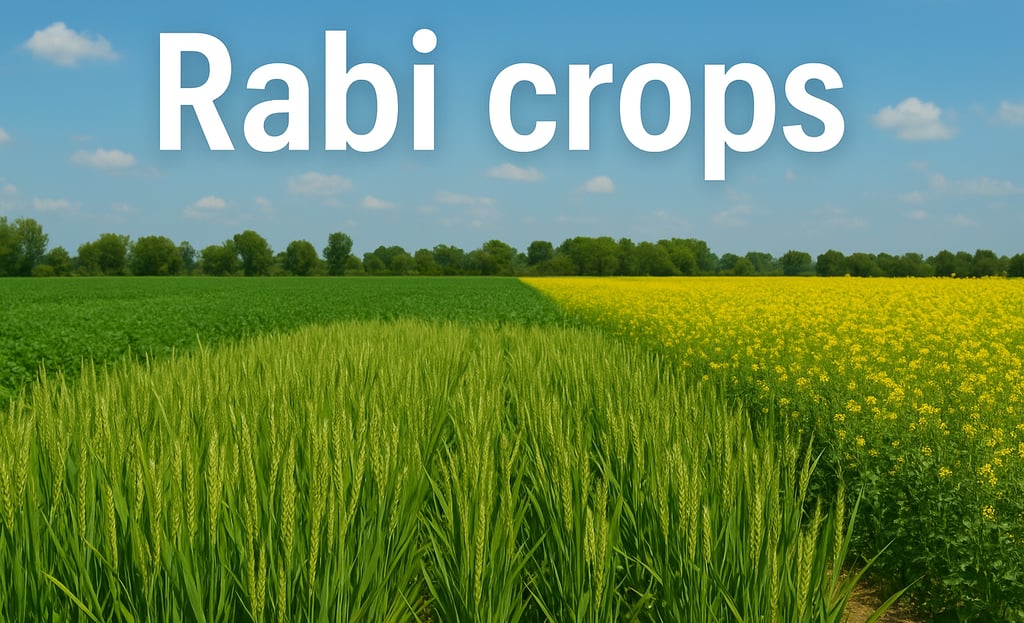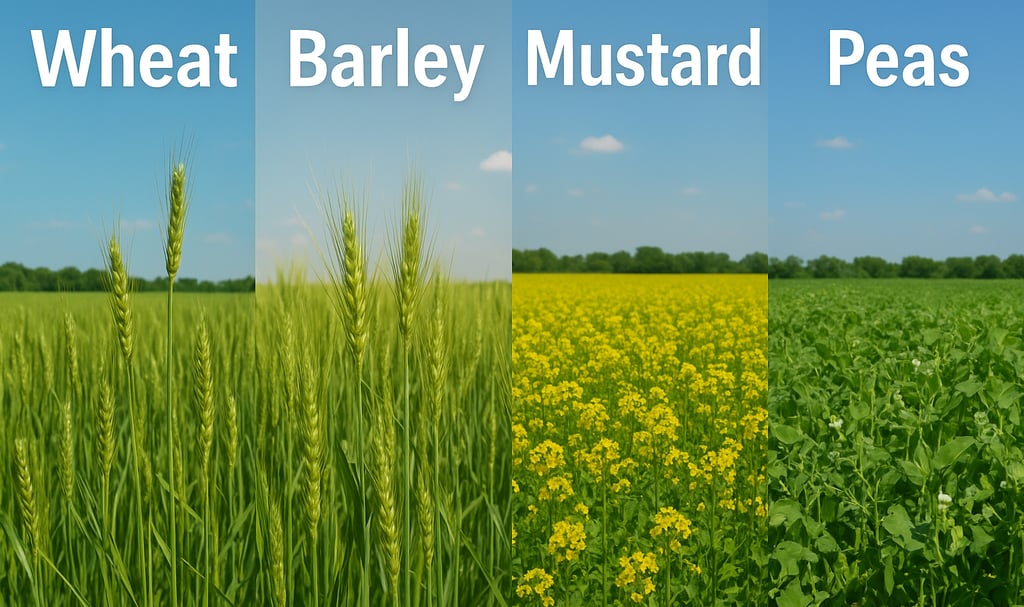Rabi Crops: Everything You Need to Know
Rabi Crops: The term 'rabi' is derived from the Arabic word meaning 'spring,' reflecting the growth pattern of these crops, which typically flourish during the cooler months of the year, specifically from November to April in the Indian subcontinent.
CROP MANAGEMENT
8/31/20258 min read


Understanding Rabi Crops
The term 'rabi' is derived from the Arabic word meaning 'spring,' reflecting the growth pattern of these crops, which typically flourish during the cooler months of the year, specifically from November to April in the Indian subcontinent. Rabi crops are primarily sown after the monsoon season, influencing their development cycle and yielding potential. The agricultural significance of rabi crops cannot be overstated; they play a crucial role in food security and the livelihood of farmers in many regions.
Rabi crops generally thrive in a climate with cool weather and adequate sunlight, which distinguishes them from kharif crops. Kharif crops, which include crops like rice and maize, are sown during the monsoon season, relying heavily on rainfall for their growth. In contrast, rabi crops benefit from the residual moisture left in the soil after the monsoon and are ideally suited for regions where winter temperatures are moderate. This seasonal pattern allows for optimum growth and harvest, leveraging the dry period post-monsoon to yield crops such as wheat, barley, and various pulses.
The climatic requirements for rabi crops include cool temperatures, with a need for warmth during the later stages of development to ensure a good harvest. States such as Punjab, Haryana, and Uttar Pradesh are well-known for their extensive rabi crop cultivation due to the favorable climatic conditions available in these areas. Understanding the variations between rabi and kharif crops is essential for farmers and agricultural planners alike, as it enables them to optimize sowing times and resource allocation, ensuring that they achieve maximum productivity from their fields.
Key Characteristics of Rabi Crops
Rabi crops, primarily cultivated during the cooler months, are characterized by their specific growth cycle and environmental requirements. These crops are sown at the onset of winter and harvested in the spring, specifically from October to March in many regions. This distinct growth cycle is crucial as it aligns with the seasonal climate, allowing for optimal germination and maturation conditions. Rabi crops typically flourish in temperatures ranging from 15°C to 25°C, showcasing a remarkable resilience to colder weather compared to their kharif counterparts, which require warmer conditions for growth.
The soil requirements for rabi crops are another vital aspect of their cultivation. These crops thrive in well-drained loamy or sandy soils that support adequate moisture retention while preventing root rot. The presence of essential nutrients and organic matter significantly enhances the growth potential of rabi crops. Farmers are often encouraged to conduct soil testing to assess pH levels and nutrient content, which can aid in the selection of suitable fertilizers and amendments, thus promoting healthy crop growth.
Irrigation needs for rabi crops vary significantly, influenced by the moisture levels in the soil and the specific climate of the region. While rabi crops can survive on residual soil moisture, they may require additional irrigation during dry spells to ensure optimal growth. Practices such as drip irrigation or sprinkler systems can help provide adequate water supply, promoting their health and productivity. Overall, understanding the key characteristics of rabi crops, including their growth cycle, soil preferences, and irrigation needs, is essential for successful cultivation and maximizing yield in agricultural practices.
Major Types of Rabi Crops
Rabi crops, typically grown during the winter season, hold significant importance in regions with distinct climatic variations. Among the primary rabi crops, wheat, barley, mustard, and peas stand out due to their extensive cultivation and economic value.
Wheat is the most widely grown rabi crop, dominating the agricultural landscape in several countries, particularly in India. It requires well-drained loamy soils and grows best with a winter temperature range of 10-15°C. The cultivation of wheat has increased significantly over the years, currently covering approximately 29 million hectares in India alone, contributing immensely to the national food security.
Barley is another essential rabi crop, thriving in regions with lower rainfall. This hardy cereal is typically sown after the first rain of the winter season, preferring temperatures between 18-20°C for optimum growth. Barley's cultivation has witnessed a rise in northern states like Rajasthan and Punjab, with about 6 million hectares dedicated to its production. Importantly, this crop is valued for both human consumption and as fodder for livestock.
Mustard, primarily grown for its oil-rich seeds, is a vital rabi oilseed crop. It fares well in cool climates, with an ideal growth temperature of 15-20°C. During the recent crop year, mustard was cultivated on over 6 million hectares in India, emphasizing its significant role in the agricultural economy. The oil extracted from mustard is not only popular for cooking but also has industrial applications.
Peas, widely recognized for their nutritional value, are cultivated in many parts of India during the rabi season. They prefer cool weather with temperatures around 10-18°C and require rich, well-drained soil for optimal growth. Statistics indicate that around 3 million hectares are dedicated to pea cultivation, showcasing its relevance both as a vegetable and as a protein source in diverse diets.
In summary, the major types of rabi crops—wheat, barley, mustard, and peas—are integral to the agricultural economy, each contributing uniquely to food security and nutritional needs across various regions. Their careful cultivation and management are crucial for maximizing yield and supporting local communities.
Cultivation Practices for Rabi Crops
Successful cultivation of rabi crops requires a strategic approach to various practices that directly influence yield and quality. One of the initial steps is seed selection, where choosing high-quality seeds suited to local climatic conditions and soil types is paramount. Farmers should prioritize certified seeds that have proven resistance to prevalent diseases and pests while ensuring they are suitable for the specific rabi segment being cultivated, such as wheat, barley, or chickpeas.
Sowing techniques play a crucial role in establishing crops. Rabi crops are typically sown from late October to early December, leveraging the moisture retained in the soil from the monsoon season. Farmers should adopt practices such as row planting to facilitate better spacing and air circulation, which are essential for healthy crop development. Moreover, incorporating soil amendments like compost or well-rotted manure can enhance soil fertility, providing essential nutrients that boost crop growth during this dry season.
Irrigation management is critical, especially in regions where rainfall is inadequate. Drip irrigation or sprinkler systems can significantly improve water efficiency, ensuring that rabi crops receive the necessary moisture during key growth stages. Regular monitoring of soil moisture levels is also recommended to avoid both water stress and over-irrigation, which can lead to root diseases.
Pest control measures should be integrated from the onset of cultivation. Farmers can utilize a combination of methods, including cultural practices, biological control, and judicious use of chemical pesticides, to effectively manage pest populations. Crop rotation, intercropping, and the use of pest-resistant varieties are additional strategies that can contribute to sustainable pest management.
By focusing on these cultivation practices, farmers can maximize the yield and quality of rabi crops, thereby contributing to food security and economic stability in their communities.
Challenges in Rabi Crop Farming
Rabi crop farming, which takes place during the winter season, often presents several challenges that can affect the overall yield and quality of the harvest. One significant obstacle faced by farmers is the prevalence of pest attacks. Various pests, such as aphids and armyworms, can infest rabi crops, compromising their integrity. Farmers must remain vigilant and adopt integrated pest management strategies to mitigate these issues, which may include crop rotation, the use of resistant varieties, and biological control methods.
Disease management is another critical challenge in rabi crop farming. Various fungal, bacterial, and viral diseases can spread rapidly among susceptible crops. For instance, powdery mildew and blight are common ailments that can drastically reduce crop yield. Farmers are encouraged to implement disease-resistant crop varieties and adhere to recommended agronomic practices, such as proper spacing and timely application of fungicides, to minimize the impact of these illnesses.
Climate change has also emerged as a formidable factor affecting rabi crop productivity. Variability in temperature and precipitation patterns can disrupt planting schedules and lead to erratic crop performance. Farmers may face unexpected weather events, such as unseasonal rains or frost, which can adversely impact the rabi crops' development. To counter these adverse effects, it is essential for farmers to adopt adaptive strategies, such as selecting climate-resilient varieties and modifying irrigation practices to enhance water conservation.
Additionally, economic factors play a crucial role in the overall efficacy of rabi crop farming. Fluctuations in market prices, input costs, and access to credit can significantly influence farmers' ability to invest in their crops and adopt new technologies. Therefore, staying informed about market trends and seeking government subsidies can help farmers navigate these economic challenges and ensure a sustainable harvest.
The Role of Rabi Crops in Food Security
Rabi crops play a pivotal role in ensuring food security across many agricultural regions, particularly in South Asia, where they are a key component of the cropping cycle. These cool-season crops, planted during the winter months, contribute significantly to maintaining a stable food supply. By aiding in the diversification of agricultural output, rabi crops help mitigate risks related to food scarcity, which can be exacerbated by climate change and fluctuating weather patterns.
The economic implications of rabi crops extend beyond mere food production. Their cultivation supports local economies by providing jobs and incomes to farmers, contributing to the overall agriculture economy. A case in point is India, where states like Punjab and Haryana have recorded substantial increases in wheat production, a primary rabi crop. This not only meets the food demand but also strengthens the region’s economy, thus enhancing food security through local resilience. As a versatile source of nutrition, crops like barley, peas, and mustard expand dietary diversity, which is essential in meeting the nutritional needs of populations.
Beyond India, rabi crops have demonstrated their importance in countries like Pakistan and Egypt, where wheat and barley are staple crops. These countries rely heavily on rabi crops to ensure a consistent food supply throughout the year. For instance, Pakistan's shift towards increased production of rabi crops has been a strategic response to the frequent food shortages that have historically challenged the nation. This adaptation ensures that food security is not compromised, even in adverse conditions.
In addition to direct contributions to food security, rabi crops also play a role in ecological sustainability. They help in soil conservation and can enhance soil fertility, further supporting agricultural practices. Through these various contributions, it is evident that rabi crops are vital to achieving food security and bolstering agricultural economies across multiple regions.
Future of Rabi Crops: Innovations and Trends
The future of rabi crops is poised to witness significant transformations driven by advancements in technology and an increasing emphasis on sustainability. As agricultural practices evolve, innovations in seed technology are becoming pivotal. The development of hybrid and genetically modified seeds promises to enhance yields while also catering to the specific climatic conditions of various regions. These seeds are designed to be more resilient against diseases, pests, and extreme weather conditions, ensuring that farmers can reliably produce rabi crops even in less than favorable environments.
In addition to improved seed technology, sustainable farming methods are gaining prominence. Practices such as crop rotation, organic farming, and integrated pest management are being adopted to reduce the environmental impact of agricultural activities. These methods not only improve soil health but also contribute to sustainable food production, a critical aspect as the global population continues to rise. Furthermore, promoting the use of natural fertilizers and biopesticides can significantly reduce dependence on chemical inputs, aligning agricultural practices with ecological preservation.
Another notable trend is the integration of digital agriculture into rabi crop cultivation. Precision farming technologies, including the use of drones, soil sensors, and satellite imagery, are enabling farmers to monitor their fields with unprecedented accuracy. Through data analytics, farmers can make informed decisions about irrigation, fertilization, and pest control, optimizing resource use and minimizing waste. The advent of mobile agricultural applications also empowers farmers with real-time information, making it easier to manage their operations efficiently.
As these innovations continue to take root, the agricultural landscape for rabi crops will undeniably change, leading to increased productivity and sustainable practices. The commitment to enhancing food production through these technological advancements presents an exciting opportunity for the future of agriculture and food security globally.
You May Like To Read "Kharif Crops in India :Types, Climate & Soil Requirement"






"Boosting Crop Growth With Nature's Power"
Contact Us:
E Mail: support@frosil.com
Customer Care: +91 8329592991
FROSIL © 2025. All rights reserved.


'Frosil' is a fertilizer manufacturer committed to enhancing soil health and crop yields. We provide high-quality, eco-friendly products that support sustainable agriculture and help farmers achieve optimal results.
Registered Office: Gat No.96, Near Krushnai Hospital, Tandali. Tal- Shirur, Dist- Pune.
